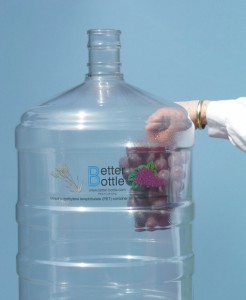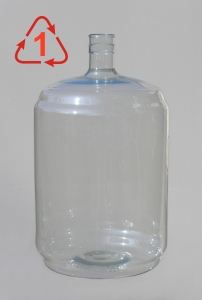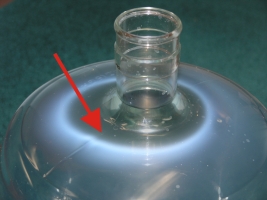|
BetterBottle Carboys and Fittings are Better
Don't Be Misled — Most types of plastic that can be made into carboys and fittings suffer from various combinations of drawbacks. Polyethylene terephthalate copolymer (PET) can be the exception, provided the PET resins are correctly designed for the purpose and converted into carboys and fittings under just the right conditions. Some PET carboys are made with varying mixtures of recycled PET. Some are made with resins that are designed to be inexpensive and intended for one-way, single-use applications. Some are intended only for potable water and little attention is paid to manufacturing conditions that affect permeability. If PET carboys are not well designed, made from specially selected PET resins, and manufactured under carefully controlled conditions that optimize the advantages of the resin; the carboys will not make the best fermenters. Fittings and valves that are not made of PET, equipped with Viton or Teflon-encapsulated Viton seals, and designed to be easily disassembled and reassembled are likely to fail under winemaking and brewing conditions.
Every new BetterBottle carboy is labeled with the BetterBottle logo and is made of a special, virgin, polyethylene terephthalate copolymer (PET) resin, re-cycle number  , using specialized, carefully controlled, production methods. BetterBottle PET carboys and fittings are widely recommended for scientific/medical laboratory applications and for fermenting wine and beer, propagating yeasts, and infusing vodka. They have been extensively field tested as fermenters since 2002. , using specialized, carefully controlled, production methods. BetterBottle PET carboys and fittings are widely recommended for scientific/medical laboratory applications and for fermenting wine and beer, propagating yeasts, and infusing vodka. They have been extensively field tested as fermenters since 2002.
Permeability — Of all the plastics that can be made into bottles and carboys, only PET has been successfully used to make containers for carbonated beverages. The reason is simple; only PET can be manufactured into sufficiently impermeable containers to prevent carbonation (i.e., carbon dioxide) from escaping and oxygen from entering. BetterBottle fermentation carboys are designed and manufactured to have such extraordinarily low oxygen permeability that they have been widely used for extended fermentations and aging. Use the Technical tab at the top of page to access a discussion of Permeability.
Purity — The special, virgin PET used to make BetterBottle carboys does not contain BPA, plasticizers, or other problem additives. It is also one of the safest and most desirable plastics to recycle. Carboys made from many other plastics smell of plasticizers, mold-release compounds, and unpolymerized organic substances that dissolve to give disagreeable, plastic flavors. Use the Technical tab at the top of this page to learn about the Purity of BetterBottle carboys.
 Flavor Scalping — BetterBottle carboys and fittings do not release or absorb flavors and odors. Other plastics do and in doing so they can spoil a wine or beer by transferring flavors from one batch to another or by contributing plastic flavors. Use the Technical tab at the top of this page and access the Flavor Scalping section for additional detail. Flavor Scalping — BetterBottle carboys and fittings do not release or absorb flavors and odors. Other plastics do and in doing so they can spoil a wine or beer by transferring flavors from one batch to another or by contributing plastic flavors. Use the Technical tab at the top of this page and access the Flavor Scalping section for additional detail.
Clarity and Color — BetterBottle carboys are clear and colorless. It is not possible to visually gauge the progress of a fermentation when carboys are molded from colored, translucent, or opaque plastics.
Cleaning — The surfaces of BetterBottle carboys and fittings are so hydrophobic and non-porous that they wash easily and rinse down quickly. Opaque or translucent carboys are likely to be made of plastics that have rough or porous surfaces, making it more difficult to wash and rinse them and to know when they are clean. Use the Technical tab at the top of this page and access the Wash/Sanitize sections for additional detail.
Chemical Resistance — The special PET used to make BetterBottle carboys can withstand alcohols and recommended concentrations of the cleaning and sanitizing agents commonly used by winemakers and brewers. Many other plastics used to make carboys and fittings are not nearly as durable. Use the Technical tab at the top of this page and access the Material Specs and Wash/Sanitize sections for important additional details and recommendations.
|

This 6 gallon carboy appears to have been made in a stretch-blow molding machine that would not open wide enough. In order to achieve the 6 gallon capacity without increasing the diameter of the carboy, the designers of the carboy sacrificed shoulder and bottom strength by flattening both. Also, side ribs have been omitted, making the sides weak and prone to scuffing.
|
Note the excessive crystallization and strain in the walls of these carboys. They were either made with an inferior type of PET or the PET was damaged during the manufacturing process. In any case, the carboys will be more permeable and more prone to cracking.


|
Carboys Made From Other Plastics – Other types of plastics are not suitable for making fermentation carboys: 1) They are too permeable to oxygen, 2) They are not clear and colorless, 3) They scalp (release, pick up & transfer) flavors, 4) They stain, 5) They are porous and difficult to wash/sanitize, and 6) Some are made with substances, such as bisphenol-A (BPS) and ortho-phthalate plasticizers, that are considered toxic (see the Purity/Safety section under the Technical tab at the top of this page).
- The polyalkenes (polyolefins),
 high-density polyethylene (HDPE), high-density polyethylene (HDPE),  low-density polyethylene (LDPE), and low-density polyethylene (LDPE), and  polypropylene (PP); polypropylene (PP);
 Polyvinyl chloride (PVC) , which typically contains plasticizers and bisphenol-A (BPA); Polyvinyl chloride (PVC) , which typically contains plasticizers and bisphenol-A (BPA);
 Polystyrene (PS) ; and Polystyrene (PS) ; and
 A Catch-all class, Other Plastics. This class includes polycarbonate (PC), the plastic made of bisphenol-A (BPA), and mixed plastics or plastics that do not fall into any other category. A Catch-all class, Other Plastics. This class includes polycarbonate (PC), the plastic made of bisphenol-A (BPA), and mixed plastics or plastics that do not fall into any other category.
|